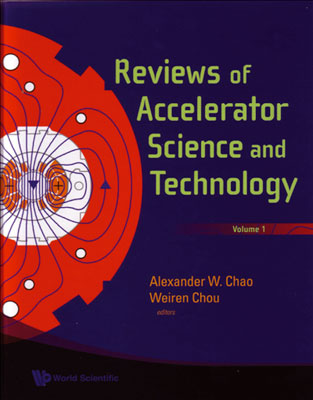By Alexander W Chao and Weiren Chou (eds), World Scientific. Volume 1 Hardback ISBN 9789812835208, £55 ($99). E-book ISBN 9789812835215, $129. Volume 2 Hardback ISBN 9789814299343, £81 ($108).
The development of accelerators represents one of the great scientific achievements of the past century. The objective of this new journal – Reviews of Accelerator Science and Technology – is to give readers a comprehensive review of this dynamic and interesting field and of its various applications. The journal documents the tremendous progress made in the field of accelerator science and technology and describes its applications to other domains. It also assesses the prospects for the future development and use of accelerators.
The history and function of accelerators is told from its beginnings and extends to future projects in an extremely competent and complete approach, as the authors have themselves contributed in many ways to the success of the fields presented. The journal shows clearly how progress in science is strongly coupled to advances in the associated instruments, allowing us to see beyond the macroscopic world – into the finer structure of matter – and to apply these instruments to fields such as elementary particle physics, medicine and industry. From the structure of cells, genes and molecules to the Standard Model of elementary particles, the scientific developments are recounted back to the early development of these versatile instruments.

Volume 1 presents the history of accelerators, from the first table-top machines to the colliders of today and those being planned for the future. It is written in a fashion that serves as a historical account while also providing the scientific and technical basis for a deeper understanding. The volume transmits the spirit of this truly multidisciplinary and international field. With an excellent bibliography for each chapter, together with the historical development of the science of accelerators and the contributions by key figures in the field, it succinctly describes the overall history and future prospects of accelerators.
The articles in this volume include a review of the milestones in the evolution of accelerators, a description of the various types of accelerators (such as electron linear accelerators, high-power hadron accelerators, cyclotrons, colliders and synchrotron-light sources) as well as accelerators for medical and industrial applications. In addition, various advanced accelerator topics are discussed – including superconducting magnets, superconducting RF systems and beam cooling. There is also a historical account of the Superconducting Super Collider, and an article on the evolution, growth and future of accelerators and of the accelerator community.

Volume 2 focuses on the first of many specific subfields, its theme being medical applications of accelerators. Out of about 15,000 accelerators of all energies in existence today, more than 5000 are routinely used in hospitals for nuclear medicine and medical therapy. The articles in this volume feature overviews of the medical requirements written by physicians; a review of the status of radiation therapy, radioisotopes in nuclear medicine and hospital-based facilities; a detailed description of various types of accelerators used in medicine; and a discussion on future medical accelerators. In addition, one article is dedicated to a prominent figure of the accelerator community – Robert Wilson – in recognition of his seminal paper of 1946, “Radiological Use of Fast Protons”.
These first two volumes of Reviews of Accelerator Science and Technology are timely, instructive and comprehensive. The journal is well laid out and, thanks to the many informative photos and diagrams, it is easy also to read. It is written in an impartial and balanced way and covers the achievements made at several laboratories around the world. To ensure the highest quality, the articles are written by invitation only and the submitted papers have all been peer-reviewed. An editorial board consisting of distinguished scientists has also been formed to advise the editors.
The journal represents an excellent balance between a historical account of the developments in the field and the technical challenges and scientific progress made with such machines. Volume 2 in particular comes at an auspicious moment because the synergies between the science behind accelerators and the related spin-offs, such as the applications of accelerators to fight disease, are of great importance to human health – with a profound impact on our society.
In conclusion, the journal is a tribute to accelerators and the people who developed them. It appeals to the expert as well as to all scientists working and applying the use of accelerators. Active scientists and historians of science will appreciate this chronicle of the development of accelerators and their key role in the progress of various domains during the past century. It should be on the shelf of every scientist working with accelerators and of those with an interest in the history and future directions of accelerators and their applications. I hope that it also inspires students to look deeper into accelerator science and technology and to choose this field as a career.








